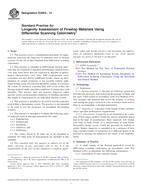Potřebujeme váš souhlas k využití jednotlivých dat, aby se vám mimo jiné mohly ukazovat informace týkající se vašich zájmů. Souhlas udělíte kliknutím na tlačítko „OK“.
ASTM E2923-14
Standard Practice for Longevity Assessment of Firestop Materials Using Differential Scanning Calorimetry
Automaticky přeložený název:
Standardní praktiky pro dlouhověkost hodnocení protipožárních materiálů pomocí diferenciální skenovací kalorimetrie
NORMA vydána dne 1.5.2014
Informace o normě:
Označení normy: ASTM E2923-14
Poznámka: NEPLATNÁ
Datum vydání normy: 1.5.2014
Kód zboží: NS-46270
Počet stran: 5
Přibližná hmotnost: 15 g (0.03 liber)
Země: Americká technická norma
Kategorie: Technické normy ASTM
Kategorie - podobné normy:
Anotace textu normy ASTM E2923-14 :
Keywords:
Borchardt and Daniels kinetics, differential scanning calorimetry (DSC), fire stop, firestop, longevity, ICS Number Code 13.220.20 (Fire protection)
Doplňující informace
| Significance and Use | ||||
|
5.1 Firestop systems are exposed to fire tests and classified using materials that have been, in all likelihood, quite recently manufactured. The testing provides a fire resistance rating for the firestop system that is measured in hours. The goal of firestop system testing is to identify and list firestop systems that will have a fire resistance rating that is no less than the fire resistance rating of the classified wall or floor assembly in which it is installed. A building fire that could put the firestop system to the test can occur at any time during the life of the building. By that time, the firestop system is composed of materials that have aged. Some assurance is desired to establish quantitatively that the firestop system will continue to have a fire resistance rating that is no less than that of the wall or floor assembly. 5.2 This practice provides one method for examining whether any changes are to be expected in the characteristics of a firestop material during its design life, as gauged by any chemical reactions that occur within the material to change it. The measurement of conversion rate provides a standard measure of how much a material will change over its design life. This provides an objective indication of whether the bulk of the material is likely to exhibit the desirable properties for which it was chosen in the firestop system. 5.3 Measurement of conversion rate allows different firestop materials used for similar purposes to be compared with respect to their ability to remain unchanged during their design life. 5.3.1 This allows materials with an unusually high conversion rate to be questioned and possibly rejected early on during the research and development process. 5.3.2 This allows materials to be screened by testing and listing agencies to ensure that they do not provide a listing for products that are not likely to have adequate performance for the full length of the intended design life. 5.3.3 This allows formulation changes that have no apparent impact on the results of the fire testing to be evaluated for any possible long-term consequences on performance. 5.3.4 Re-calculation of the conversion rate (other than for the standard time and temperature specified in Section 5.4 Measurement of conversion rate allows longevity of firestop materials to be compared to the longevity of the classified wall or floor assemblies in which the firestop system is installed, by measuring the conversion rate for each. This comparison can ensure that the firestop system does not degrade significantly faster, thus possibly deeming it to be unacceptable. The comparison can also ensure that the firestop system is not unjustifiably held to a higher standard of longevity than the floor or wall itself. 5.5 The fundamental assumption inherent in making use of DSC conversion rate data for assessing longevity of firestop materials is that if the material has a chemical stability that keeps it from changing much over time in a certain environment, then it is reasonable to expect it to adequately perform its design function if subjected to an actual fire many years after installation. |
||||
| 1. Scope | ||||
|
1.1 This practice covers a standardized procedure for quantitatively assessing the longevity of materials used in firestop systems, by the use of data obtained from differential scanning calorimetry. 1.2 This practice is intended to differentiate firestop materials that are expected to maintain performance characteristics over time from those that are expected to degrade in performance characteristics over time. DSC experimental curve evaluation can also deliver indifferent results, where an interpretation of sample properties is not possible without additional testing using conventional durability testing. It evaluates the extent of chemical reactions that will occur within the firestop material under specified conditions of temperature and humidity. This practice does not measure longevity under specific severe environmental conditions or building operation that might be experienced by an individual firestop system. 1.3 This practice is intended to be used to test the materials used within a firestopping system. The practice is not intended to be used to test the properties of assembled firestopping systems. 1.4 This practice is intended to evaluate the following types of materials used in through-penetration fire stops: 1.4.1 Endothermic, 1.4.2 Intumescent, 1.4.3 Insulation, 1.4.4 Ablatives, and 1.4.5 Subliming. 1.5 The values stated in SI units are to be regarded as standard. No other units of measurement are included in this standard. 1.6 This standard does not purport to address all of the safety concerns, if any, associated with its use. It is the responsibility of the user of this standard to establish appropriate safety and health practices and determine the applicability of regulatory limitations prior to use. Some specific hazards are given in Section 8 on Hazards. |
||||
| 2. Referenced Documents | ||||
|
Doporučujeme:
Aktualizace zákonů
Chcete mít jistotu o platnosti užívaných předpisů?
Nabízíme Vám řešení, abyste mohli používat stále platné (aktuální) legislativní předpisy.
Chcete vědět více informací? Podívejte se na tuto stránku.




 Cookies
Cookies
